By Pat “Tube Dude” Scouten
On Monday January 25, 2010 there was a winter carp seining session in the Goshen Bay area on Utah Lake. It was conducted by the Loy family fishing operation and open to public observation. In addition to the contracted fishermen there were several representatives of Utah DNR and members of the June Sucker Recovery program on the ice. There were also members of the Big Fish Tackle fishing website observing and trying to get in the way as much as possible.
It was a “nice” winter day. Air temps started in the low 20’s and pretty much remained there through the day. No snow, no brutal winds and it was possible to even take your gloves off periodically without losing fingers to frostbite.
The edges of the lake had softened a bit in previous days during a “warming trend” but they were still plenty strong for both people and assorted machinery to get out on the thicker ice of the main lake. A few feet from the edge the ice became a STRONG 12 inches or more and supported the large group of onlookers as well as the vehicles and net pulling gear of the carp fishermen.
About 9 AM the fishermen loaded up their nets, ropes, stringing tools and other gear and headed out onto the ice. They had measured off the haul area the day before and had cut most of the necessary holes. However, an additional 2 inches of ice had frozen in each of those holes after nighttime temps dropped into the teens. The first order of business was to take a heavy fire ax and chop out the refrozen access holes.
It might help to better convey the tremendous amount of work involved in seining carp through the ice to first set the stage…with distances and dimensions. (See the diagram below)
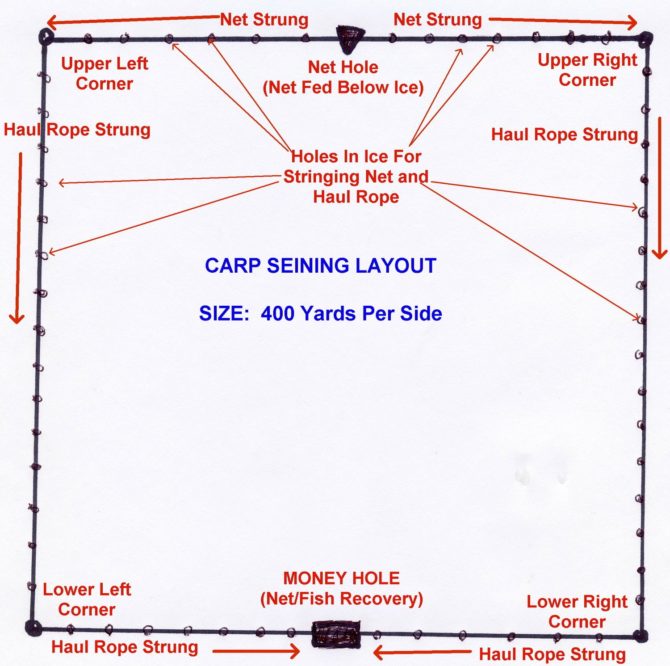
AREA:
The area for the “haul” was laid out in a large square…about 400 yards on a side. In the middle of the “bottom” side was a large rectangular hole designated for taking out the nets and handling the fish that were captured. In the middle of the “top” end of the square was a slightly smaller hole…through which the nets would be fed into the water and pulled toward each of the top end corners. Along all 4 sides of the huge square was a series of 12” holes, spaced about 25 paces apart. These holes are used to push wooden rope-pulling slats along under the ice, from hole to hole, with the main heavy nylon rope attached to the rear end of the slats.
Doing the math suggests that there are 16 threading holes along each side of the square…64 holes to be drilled out and then chopped free of ice again the following morning. Add in the chainsaw work on the net holes and there is some serious expenditure of human effort involved just in opening and maintaining the holes.
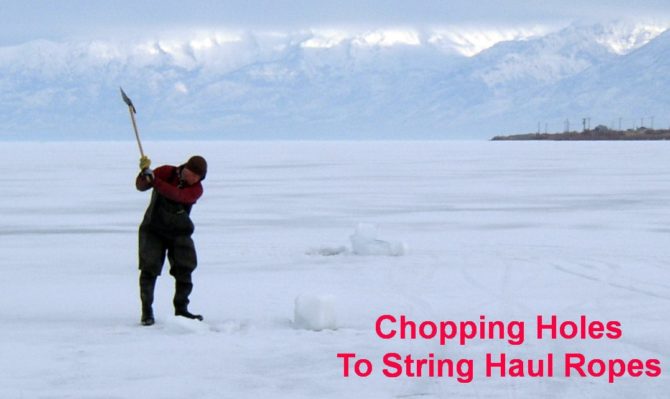
RUNNING THE ROPES PHASE 1:
The large sled with the 400 yards of seine net is hauled out to the smaller triangular hole at the middle of the top end of the square. But, before the net can be pulled under the ice the ropes must be run across the entire top of the square…in both directions from the middle net hole to the top corners. Several 10’ long wooden slats, ½” thick and about 4” wide, are connected at the ends to form one long floating and flexible puller for stringing the rope from hole to hole. It is pushed down into the large net hole and guided toward the first 12” hole either to the right or left. The main heavy nylon rope is secured to the back end and pulls the rope along behind as it is pushed from hole to hole. As the rope stringer finishes pushing the slat along to the next hole and comes to the end of the slat he walks up to the next hole. Hopefully the wood slat is clearly visible in the water beneath the hole, ready for him to start pushing it toward the next hole. If not, he has a “seeking” tool made from bent conduit pipe. Fortunately, these guys are experienced and very good at lining up the slats from hole to hole.
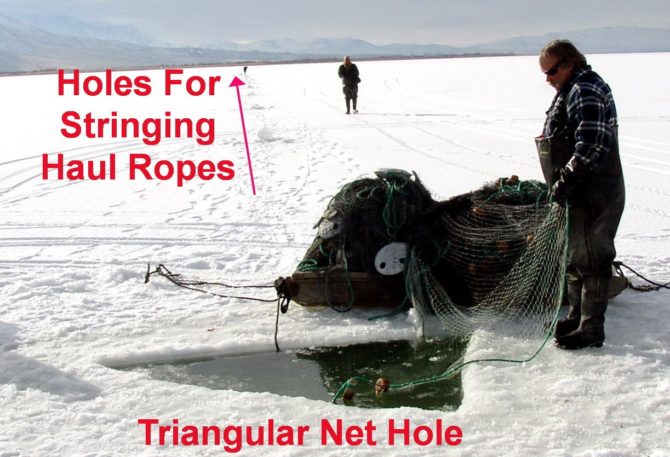
STRINGING THE NET:
Once the ropes have been properly strung across the top end of the square, the inside ends of these ropes are tied onto the outside ends of the nets at the center hole. People at the top corners then begin pulling on the ropes to haul the ends of the nets down into the net hole and out toward the two top corners of the square. Once the net has been completely strung across the top leg of the square, the fishing process can begin.
For this particular haul, the nets were about 10 feet high and the water depth beneath the ice was only about 8 feet. There are floats along the top of the net to keep it hanging vertically, just under the ice. There are weights and metal skids on the lower edge of the net to keep it on the bottom during the haul process.
RUNNING THE ROPES PHASE 2:
The nets are now hanging inertly in the water from corner to corner all along the top of the square. Next, the heavy main haul ropes are run down each side of the square, toward the bottom edge. The same floating slats and push poles are used to run the ropes from the top corners to the bottom corners.

TURNING THE BOTTOM CORNERS:
When the ends of the heavy nylon ropes reach the two bottom corners of the square, sleds with motorized winches are moved into place at each corner to begin pulling the nets toward the bottom of the square and into the big rectangular net hole. Each of these winches pulls rope slowly and the ends are fed down each half of the bottom of the square…toward the MONEY HOLE in the middle.
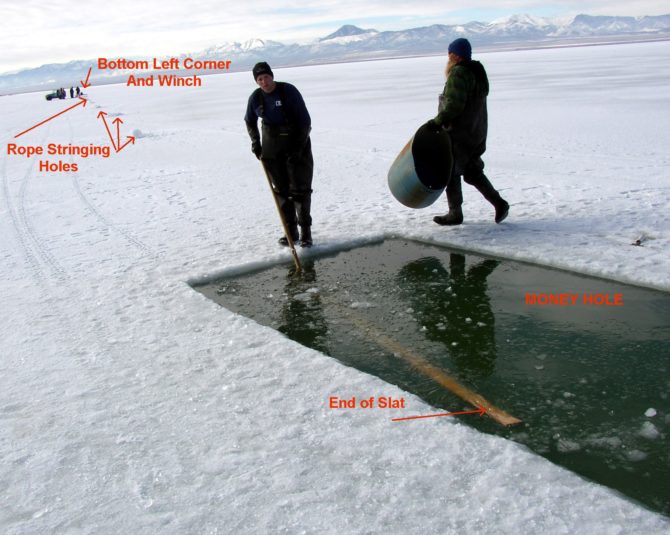
MAKING THE HAUL:
Once both rope stringing slats come out of the rectangular net hole…and both ends of the haul ropes are on the ice…the two motorized winch sleds are moved into place…one at each side of the MONEY HOLE. First the winches retrieve only the excess haul rope. Then the ends of the net come into the hole and are joined. From that point on only one winch pulls both sides of the net together. The seine is pulled across the designated area of the haul, as quickly as possible. The intent is to gather and trap as many fish as possible as the ends of the net meet at the hole and the “bag” of the net is brought up to reveal the catch. To streamline the process, the nets are just strung out on the ice for proper folding and storage later. When there are fresh fish in the bag all hands must work to get them sorted and processed.
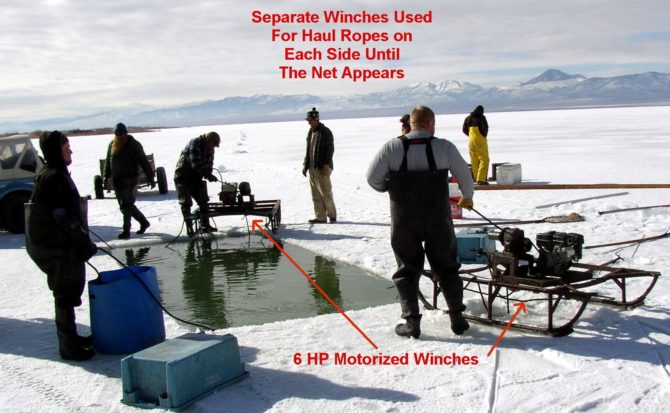
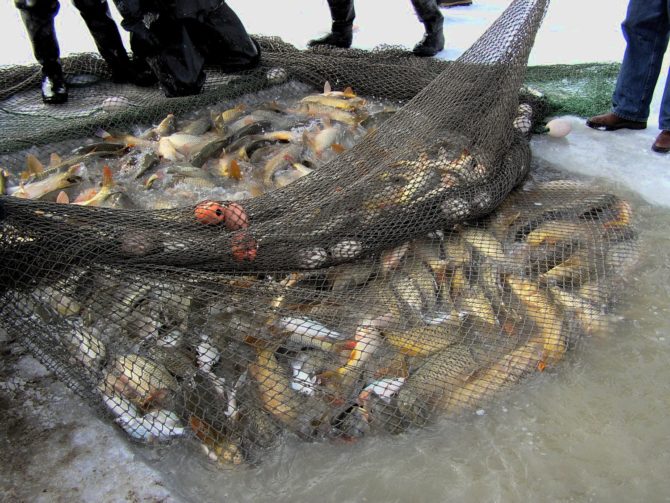
Here is the net being brought up through the big rectangular hole. There are lots of carp and a few each of several other species.
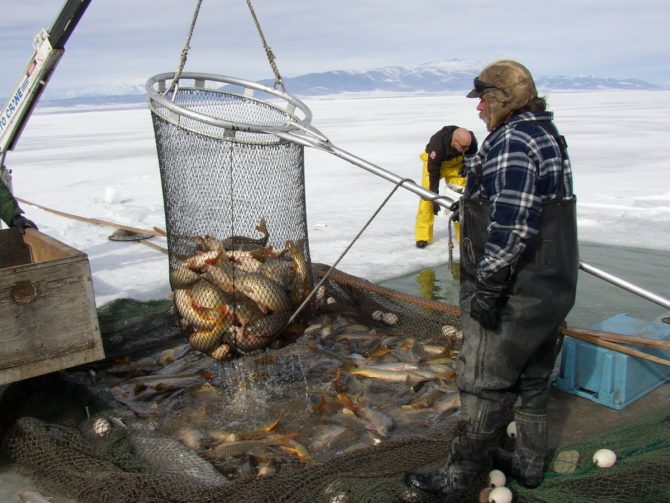
The contract fishermen set up their mini-hoist and the large dip net arrangement to scoop out large quantities of carp and deposit them in a trailer by opening the draw string on the bottom of the dip net. The carp are then trucked to a predetermined drop off or storage point.
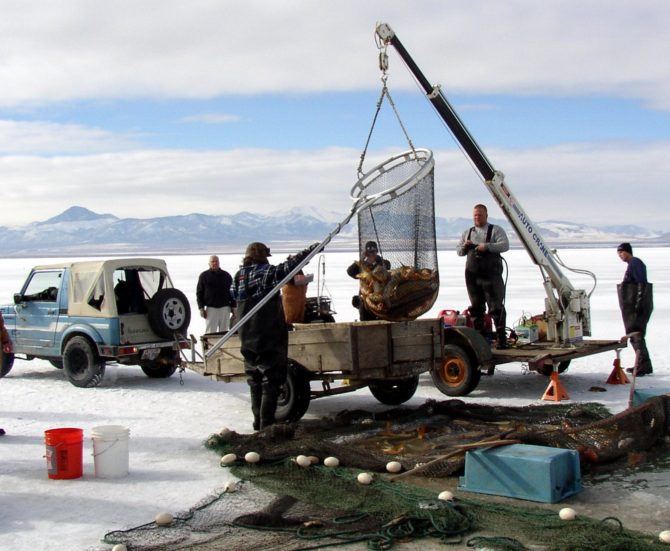
The draw string on the bottom of the hoist net is opened to dump the fish into a trailer…towed behind an ice-worthy vehicle to the heavier trucks waiting on solid ground a short distance away. There they are offloaded onto conveyor belts that move them up into the trucks.
TODAY’S RESULTS:
It was estimated that the nets scooped an area roughly equal to about 50 acres in size. The “net” haul was not as good as the contract fishermen had expected but there was still a large quantity of carp. There was also a good cross section of most other species known to inhabit Utah Lake. This included several large channel cats, a few nice walleyes, some dandy yellow perch, quite a few decent bluegills, some average crappies and even some chunky largemouth bass. Of course a few omnipresent bullheads found their way into the net too. There was only one wayward June sucker in the haul. Of course the biologists quickly give it a big kiss and sent it back into the hole.
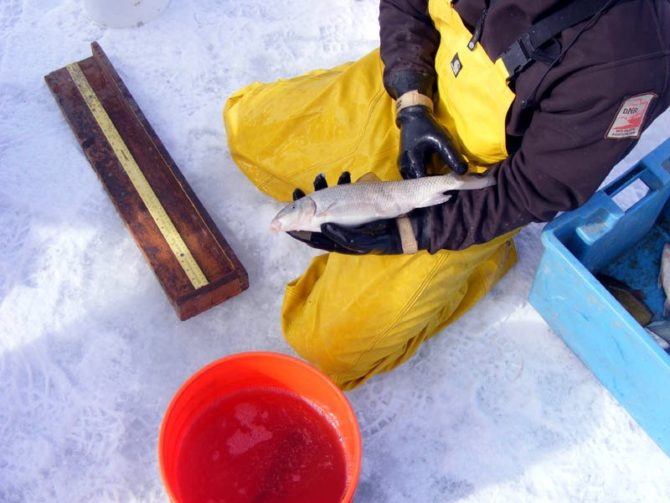
There was one June sucker captured in the nets on this trip. The Junie is the reason for the whole carp netting thing anyway.
SORTING AND PROCESSING:
Biologists from Utah DNR scurried to “rescue” non-carp species from the haul bag as quickly as possible. They separated them by species and recorded lengths and weights. Most were successfully returned alive through the large rectangular hole.
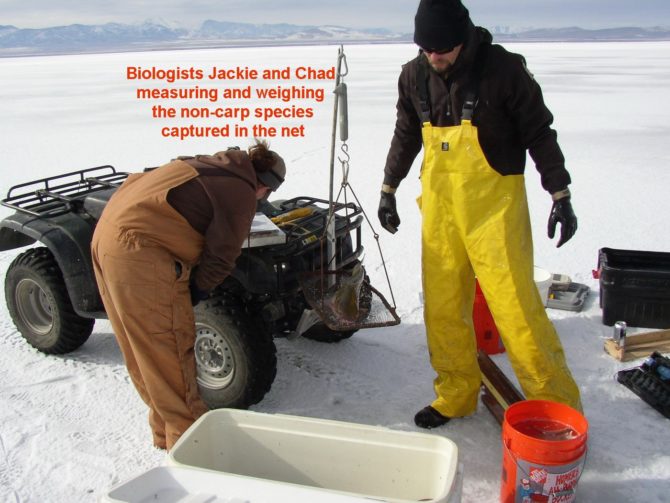
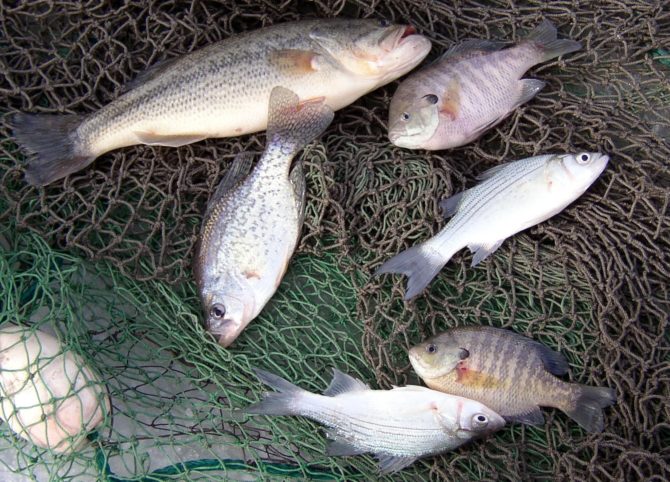
There were a lot of white bass, a fair number of crappies and bluegills and a smattering of large mouths. These are known as “by catch”.
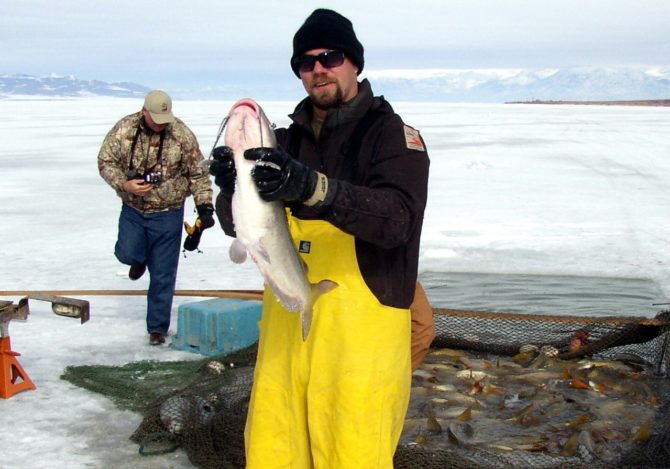
A lot of catfish fans would love to catch a channel cat like this one that crawled in with the carp.
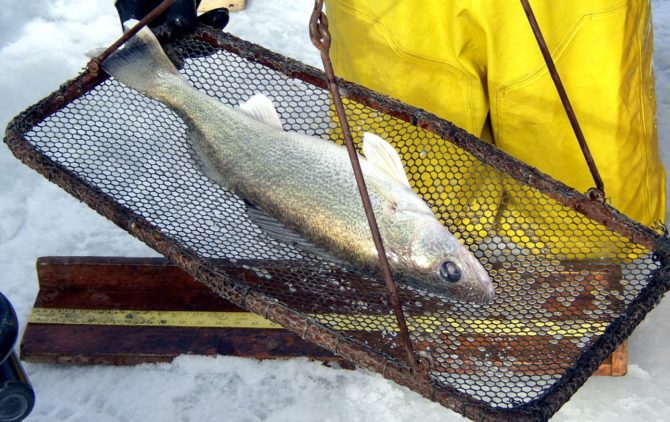
Several fat healthy walleyes showed up in the carp haul.
**This blog post is a historical report, written in 2010 by Pat “Tube Dude” Scouten. The process of carp removal is constantly being evaluated and updated. the purpose of this post is to highlight past efforts and educate those interested on how the removal process works.
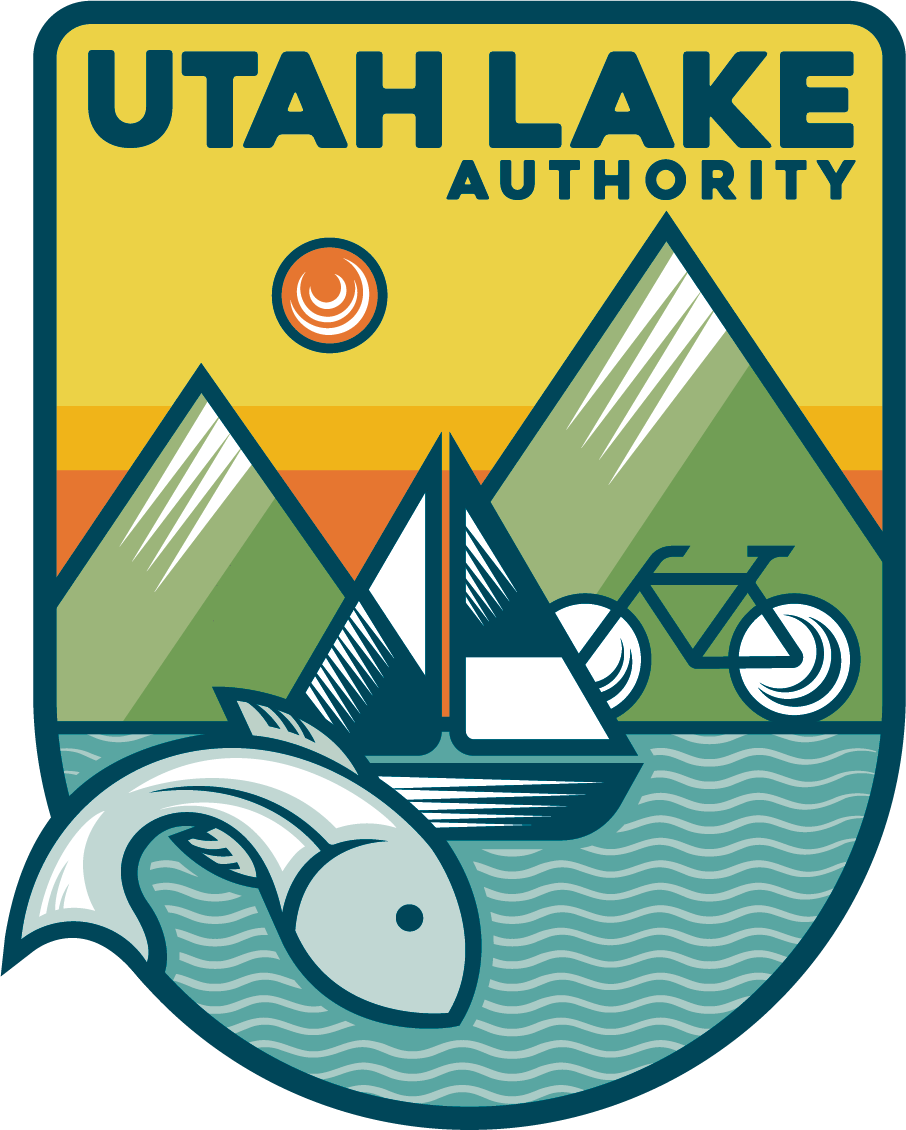

I would like to come observe the taking process and possible but a carp or two for bait this summer. Is that possible?
How and when wold I be notified of the next operation?
Bob
Bob,
Thanks for commenting! We would recommend you contact the organization responsible for the carp removal, which is the June Sucker Recovery Implementation Program to make your request to observe. Their website is: http://junesuckerrecovery.org/. Contact info is listed on their website.